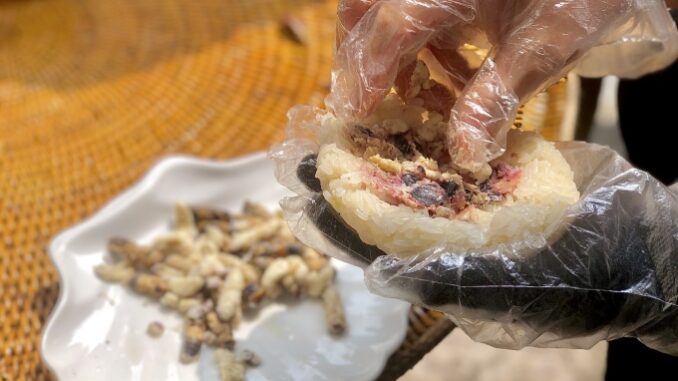
Ground wasp pupae soaked in black canarium fruit meat wrapped in upland sticky rice is a dish in Dien Bien at the end of the year when the weather is cold.
The early autumn and cold weather is the time of black filling in the Northwest mountains in general and Dien Bien in particular. And from September to before the Lunar New Year, people here often harvest ground bee pupae. Coming to Dien Bien on cold days, visitors have the opportunity to enjoy a specialty combination of black canarium and steamed ground bee pupae eaten with upland sticky rice.

Owning a restaurant in Noong Chan village, Nam Thanh ward, Dien Bien Phu city, Ms. Dao Thi Nhung (33 years old) was invited by the Vietnam Culinary Culture Association (VCCA) to participate in the Hanoi Fall Festival 2023 (June 29). 9 – 1/10). In addition to the familiar dishes in the traditional rice tray of the Black Thai people such as grilled carp, minced pork wrapped in grilled banana leaves, buffalo meat on the stove, wild vegetable salad and five-color sticky rice, Ms. Nhung brings the dish of pickled ground bee pupae. black filling.
According to Ms. Nhung, this is a “cold day specialty” in Dien Bien. Ground bees are poisonous but are loved and hunted for the nutritional value they bring. “Bee pupae are a rare dish of the Northwest mountains and forests, there is only one season per year,” said Ms. Nhung.
Dien Bien people choose banh te pupae (not too young nor too old), milky white, the size of a little finger. When harvested, the pupae remain in the wax. People remove the pupae and dip them in hot water to firm up the meat. Then wash with diluted salt water to disinfect, remove slime, and rinse with clean water. After being cleaned and processed, the bee pupae are steamed for about 5-7 minutes. In this way, the pupa retains its original shape and color.
Black canarium mixed with steamed ground bee pupae must be a type of forest canarium, the fruit is small, tapered at both ends, the skin is smooth and unspotted, and has a layer of white powder on the outside. The canarium fruit is dropped into boiled water to cool to about 50 degrees Celsius for more than half an hour until soft. Use your hands to break the fruit in half to separate the seeds and flesh. The flesh of the filling is pinkish purple and has a rich, sour aroma.

The ingredients for cooking sticky rice are upland sticky rice, with large, round, plump grains. Rice is soaked in water for about 3 – 4 hours and then cooked for 30 – 40 minutes over low heat.
The correct way to eat this dish is to crush the bee pupae with the flesh of the black canarium fruit. “You can knead it by hand, but using a mortar and pestle will make it smoother and smoother,” Ms. Nhung said. Then take a handful of sticky rice, spread it into a circle, then put the mixture of bee pupae and black filling in the middle, wrap it into a handful. Between the white color of the sticky rice and the bee pupae, the purple-pink color of the black canarium flesh stands out, creating an attractive look for the dish.
Diners can feel the greasy taste of ground bee pupae, the fleshy taste and a little sourness and astringency of black canarium fruit, and the elasticity, aroma and sweetness of upland sticky rice. Mr. Tran Manh (Hanoi) said he was “most impressed” with this dish in the traditional rice tray of the Black Thai people in Dien Bien. According to him, most other dishes are marinated with Mac Khen seeds, but sticky rice with bee pupae is prepared by steaming, retaining the original flavor. “Making bee pupae helps people who are afraid of insects enjoy it,” Mr. Manh said.
Looking at the traditional rice tray of the Black Thai ethnic group performed at the Hanoi Autumn Festival, Ms. Pham Minh Hang (42, Hanoi) was attracted by this “dish made from insects”. However, because bee pupae are limited, she cannot enjoy them much. “The dish is a bit bland for my taste, but I can clearly feel the rich, greasy taste,” she said.

A family enjoys dishes from the traditional rice tray of the Black Thai people in Dien Bien on September 30.

Traditional rice tray of the Black Thai ethnic group during Hanoi’s autumn estival on September 30 at Hanoi Children’s Palace.

Ms. Nhung introduced types of Dien Bien rice, including upland sticky rice.

Dien Bien rice varieties displayed at Ms. Nhung’s stall.

A handful of upland sticky rice filled with steamed ground bee pupae and black canarium.

Ms. Nhung’s Dien Bien food stall attracts many diners.

Mr. Manh (right) enjoys wild vegetable salad and ground bee pupae with black canarium.
According to researchers, wild bee pupae contain a lot of fat, sugar, amino acids, vitamins and minerals such as calcium and phosphorus. Bee pupae are effective for people with nervous breakdown and insomnia.
Although bee pupae are a nutritious and benign dish, some cases are allergic due to physical factors. Therefore, diners should try eating a small amount. If they do not see signs of rash, red face, dizziness, stomach pain, or vomiting, they can continue eating, according to the information portal of District 5 Medical Center. Ho Chi Minh City.
Ground bee pupae soaked in black canarium eaten with upland sticky rice is a dish combining local products, preserved by the Black Thai ethnic people in Dien Bien for many generations. This dish is indispensable in the traditional dinner table of the Black Thai people on holidays, Tet, weddings, especially when entertaining distinguished guests.
Photo,Video: Internet (Vinlove.net)
